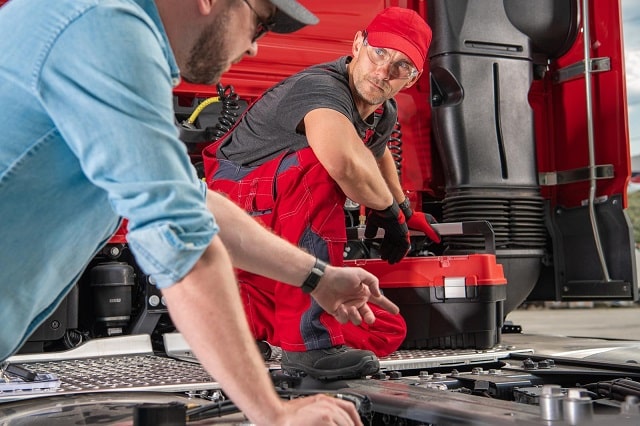Operating a commercial fleet of vehicles is no small undertaking. No matter what types of vans or trucks your company uses, keeping these vehicles compliant with all applicable regulations and properly maintained is an effort that can feel gargantuan without the right plan. Fleet maintenance expectations alone are enough to stress out even experienced fleet managers.
That’s why we’ve created this in-depth guide to fleet maintenance. We’ll not only tell you what exactly fleet maintenance is, but once you’re done reading, you’ll be up to speed on how to create an effective maintenance plan, which KPIs to measure, the digital tools you should be adding to your arsenal, and more. If you’re still wondering how to determine, plan, and carry out maintenance across a fleet of commercial vehicles, this guide is for you. We’ll discuss:

When people talk about fleet maintenance, they’re referring to a company’s preventive, routine servicing of the commercial vehicles used in day-to-day operations. It’s one of the most crucial components of fleet management.
What kind of routine maintenance are we talking about? The same kind that you (hopefully) routinely schedule for your personal car: oil changes, tire rotations, fluid flushes, tune-ups, brake jobs, and other common services that gas and diesel engines require.
It’s an easy misconception to think that maintenance is a catch-all term for vehicle repairs in general, but that isn’t the case. Like most mechanical machines and products, any kind of automotive service falls into two camps: preventive and reactive.
Preventive service is the same as maintenance – it’s the routine work you do to reduce the odds of sudden, unexpected failures. Examples are getting a timely oil change or replacing tires after a certain number of years.
Reactive maintenance is the opposite; it refers to conducting service only after some kind of component failure occurs. Using the term ‘maintenance’ in this context isn’t really appropriate at all because reactive servicing is essentially an emergency repair.
This approach isn’t always bad, though – the classic example of reactive maintenance is a small battery or lightbulb replacement. You’re probably not going to replace the AAs in your TV remote preemptively, and the same goes for the lightbulbs in your hallway. For simple, easy fixes like these, reactive servicing works just fine. Any more involved or serious maintenance ideally should fall under a preventive maintenance strategy.

Specific fleet maintenance plans differ wildly between companies and industries, but effective strategies typically consist of a few key elements. These can include:
Because fleet maintenance becomes a much more intricate process as your business scales and you acquire different vehicles with varying service schedules, you’ll want to iron out these basic administrative elements early on as part of your overall fleet management strategy. Once the groundwork for an effective plan is set up, you will be well equipped to continue growing your fleet and streamlining operations.
Let’s look at each of the above factors in more detail:
If you want to be proactive when it comes to vehicle maintenance, you need to know how to determine when it’s time for a visit to the shop. Unfortunately, there’s no easy answer to this, as different components often wear out at different intervals. Fleet managers also need to be aware of the appropriate rate of measurement to use when determining service intervals. The following are the three most commonly used metrics among commercial vehicle owners:
Maintenance based on these intervals is also known as usage-based maintenance.
Of these three, time and mileage are likely the most familiar to car owners – who hasn’t been told to schedule an oil change every 3,000 miles or three months, whichever comes first? Your owner’s manual should also lay out other time/mileage recommendations for service intervals. On the other hand, tires often come with impressive treadwear ratings that may be as high as 60,000 or 80,000 miles, but the threat of dry rot and internal degradation means that many car owners swap them out after 5-7 years regardless of the tread’s condition.
These recommendations carry over to commercial trucks as well, but fleet managers will also need to factor in engine hours when determining maintenance. ‘Engine hours’ is simply a measurement of the engine’s running time, and it’s something that can dramatically impact the wear and tear of a commercial vehicle. After all, truckers are no strangers to idling – one survey found that 39% of respondents indicated that their fleets idled three to four hours per day, while another 14% of fleets idled more than 4 hours per day.
Because idling is still causing wear and tear, it’s important to track engine hours for vehicles subject to excessive idling. In these instances, engine hours is a more accurate assessment of a vehicle’s usage than miles traveled. This is especially true in the case of construction equipment and other specialty vehicles, where low speeds, short distances, and long hours spent idling are the industry norm. In these cases, manufacturers usually specify maintenance using engine hours as the primary metric. Engine hours are sometimes even used by vehicle manufacturers to establish warranty limits.
When you operate vehicles subject to prolonged idling, you may need to convert engine hours to mileage to determine service intervals. Doing so is easy: it’s typically agreed that an hour of idle time is equivalent to about 60 miles worth of driving. By multiplying idle hours by 60, you’ll get a good estimate of the equivalent mileage your vehicle’s engine has traveled, enabling you to confidently set proper maintenance intervals.
When you first create a fleet maintenance strategy, it’s crucial to set up effective KPIs. These benchmark indicators measure not only the success of your plan as a whole but also the value and reliability of every vehicle in your fleet. With the right metrics in place, you’ll be able to see a detailed breakdown of just how costly each vehicle is and its propensity for requiring emergency service. Armed with this data, you can objectively determine when to repair or replace one of your trucks.
The following are some KPIs that track some of the most important fleet maintenance metrics you and your team will want to keep up on:
Some of these metrics are straightforward, such as total breakdowns and fuel costs. Others require a bit more calculation – when determining the total cost of ownership, for instance, you’ll want to take into account every relevant expense. That means fuel, service, and purchase price, but also hidden costs like insurance premiums and the impact of depreciation. Once you have all this data, you can determine the true cost per mile.
In today’s connected world, the easiest way to stay on top of your fleet’s servicing needs is to incorporate a fully integrated fleet management software, or FMS. Today’s FMS programs are a godsend to anyone reviewing, planning, scheduling and timing maintenance, not the least because they can tie directly into a vehicle’s internal computers and record every maintenance notification and diagnostic code. Many also integrate with GPS devices and other tracking solutions.
These technologies have hit their stride in the last few years, and it seems the word has gotten out regarding how much they reduce the manual legwork once required to track, analyze, and store key vehicle service information. Between 2019 and 2020, the industry saw a 12% increase in the rate of technology adoption among small fleets. These figures were even higher among larger operations.
By embracing an all-encompassing FMS, you can track miles, engine hours, and time elapsed since the last service visit for every vehicle in your fleet. The automated nature of these systems means that you can set it to trigger alerts when a vehicle is coming due for certain servicing or trigger a warning when a check engine light or other fault code is detected.
With such a vigilant digital watchdog on your side, you’ll be able to find poor maintenance practices and other inefficiencies that could be hurting financial and operational performance. You’ll also be able to focus on analyzing data in order to optimize your operations and strategically revise current practices.
Simply put, an FMS is the single greatest asset a fleet manager can have when looking to cut down on busy work, effortlessly compile relevant vehicle data, and accurately track relevant KPIs and other metrics.
Perhaps the most crucial step in initiating a fleet maintenance strategy is getting buy-in from all relevant stakeholders. After all, it’s easy enough to get a program greenlighted by corporate, but what happens if those on the front lines of your business don’t want to follow the new guidelines and expectations? Even the best plans will amount to nothing if can’t be put into practice at the ground level.
This is especially true when it comes to implementing any kind of fleet maintenance or management plan. Truckers already feel the pressure from deadlines, compliance reporting standards, road and traffic conditions, and every other factor they encounter throughout their day-to-day routines. If drivers are going to get behind any strategy your team might propose, it needs to consider the unique challenges they face every day.
This is one of the reasons a telematics solution has become so popular among fleet operators. These programs are completely unobtrusive, requiring no manual inputs from drivers when it comes to tracking vehicle metrics and staying on top of maintenance data. When warning lights come on, these systems immediately notify managers. When certain engine-hour or mileage milestones are hit, these programs prompt service reminders back at the home office to ensure the right people get on with arranging service. Because the maintenance elements of these programs are so automated, it’s an easy solution for drivers to get behind.
The other piece of the puzzle is driver training for other factors that the computer may not be able to report. A classic example of such a factor is tire pressure. Though TPMS sensors that monitor the PSI at each tire are nearly universally found on today’s passenger cars, it’s not as common among commercial vehicles – particularly older models. That means drivers need to check tire pressure themselves, as under- or overinflated tires can have a raft of consequences that affect vehicle performance.
Increased fuel consumption, exaggerated tire wear, and even complete tire failure can occur due to improperly inflated tires. In fact, Aperia Technologies, a manufacturer of an automatic tire inflation system (ATIS) for commercial trucks, says that 85% of tire failures in fleets are due to underinflated tires.
This is just one example of where driver diligence can help ensure continued performance of the vehicle, but it underscores the importance of training drivers to stay vigilant about maintenance procedures that may otherwise appear trivial. This is especially important in particularly in older models not equipped with ATIS (automatic tire inflation systems) or TMPS (tire pressure monitoring systems).

You’ll reap financial and operational benefits when you put into place a workable, actionable plan to track and schedule regular service for your fleet. Here are just some of the perks that come with a great fleet maintenance strategy:
When you take care of a vehicle, it usually takes care of you. Though preventive maintenance might feel like it’s costing more money than you’d care to spend, the basic principle – that an ounce of prevention is worth a pound of cure, as the old adage goes – couldn’t be more true.
Neglecting common maintenance items like tune-ups and oil changes can result in a poorly running engine, which in turn can lead to excess mechanical wear and increased fuel consumption. All this could very well happen without the driver ever becoming aware of it, and even an FMS program may miss catching this if performance is still within a certain OEM spec.
The result? Lots of money lost in increased fuel consumption and, eventually, premature failure of other powertrain components. Across thousands of miles and multiple vehicles, the financial impacts stemming from all this are far from insignificant – and yet the truck itself may seem to perform completely normal. On the other hand, staying on top of preventive maintenance will maximize the performance of your vehicles’ parts and systems.
By implementing a system designed to monitor your fleet’s mechanical condition, you’ll avoid these risks and save significant money in both operating costs and avoidable repair expenses.
Danger lurks in vehicles that are poorly maintained. We’ve already discussed the risks of neglected tires; what about all the componentry? Brakes are perhaps the most concerning serviceable system, as any kind of failure puts both truck drivers and other motorists at a potentially fatal risk should the brakes fail entirely. But other systems are also vulnerable to failure and could lead to needless hazards should they fail due to neglect.
Along with the safety risks associated with improperly maintained vehicles, there’s also driver satisfaction to consider. Drivers forced to tolerate trucks plagued with mechanical issues will inevitably be more dissatisfied than those who operate properly maintained trucks. Even if the trucks aren’t new, maintaining them correctly is, at the very least, a sign of respect for those who have to drive these vehicles every day.
Not only does effective fleet maintenance contribute to more satisfied employees, but it also helps you stay compliant with the many regulations your fleet may be subject to. These include regulations such as DOT Federal Safety Regulations, FMCSA, NHTSA, and GHG Phase 2 and Fuel Efficiency Standards, as well as requirements for drivers such as daily vehicle inspection reports (DVIRs), hours of service (HOS) reporting, and more.
Part of an effective fleet maintenance plan is data collection, and that data paints a picture of the overall health of your fleet. It also helps you calculate key operational metrics relating to individual vehicle expense, total cost of ownership, and other KPIs that we mentioned above.
Having this data at your fingertips allows you to drill down into your fleet and determine how effective and productive these assets are. You can determine vehicle utilization rates, review their breakdown history, track cost-per-mile metrics on a vehicle-by-vehicle basis, and more.
This wealth of information can then be stitched together to make business decisions based on objective data. Should a large, unexpected repair be completed, or should the truck instead be replaced? Are there enough vehicles in the fleet to cover models that are out for maintenance? Conversely, does the utilization rate suggest that there are too many trucks?
Without the right data, answering these questions becomes nothing more than a guess informed by gut feelings. With a data-driven fleet maintenance strategy, however, you can answer these and other tough business questions with clear, objective facts.
At the end of the day, you want to please your clients and customers. And customers aren’t going to be pleased if their deliveries or scheduled services are pushed back due to the mechanical failure of a key company truck. And while even the best fleet service strategies can’t prevent the occasional unexpected failure, the right maintenance and management can decrease the need for reactive maintenance and help inform the creation of effective contingency plans.
These aren’t just anecdotal observations, either. One report said that a 54% improvement in customer service was seen because of fleet tracking in 2020 – a year marked by logistical nightmares due to supply chain disruptions. When a strategy can have that kind of impact on your customer satisfaction ratings, there’s no reason not to fully embrace fleet maintenance.

If you’re ready to get started with a new data-driven fleet maintenance approach, the first thing you’ll want to do is adopt a fleet management software or fleet tracking software solution. There are a lot of providers out there, but here are some well-respected options to begin your search with:
We’ve discussed some of these providers in more detail in our roundup of the 25 best fleet maintenance software, so check it out for more insight on our favorite fleet software companies.
Other tools are also available to fleets to help improve vehicle maintenance. Some are analog and some are digital, but all of them are undoubtedly helpful. Here are a few favorites:
No matter what tools, software, KPIs, or other strategies you embrace, it’s critical that your business establishes an effective fleet maintenance plan as part of your overall fleet management program. With the right system in place, you’ll be well on your way to operating a leaner fleet that’s safer for drivers and more effective for customers – the perfect win-win regardless of what kind of operation you’re running.
Our sales engineers are experts in automatic asset tracking, tagging and identification,a nd can answer all your questions. Get in touch now.
Lets Talk ›